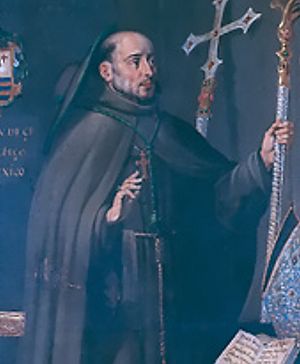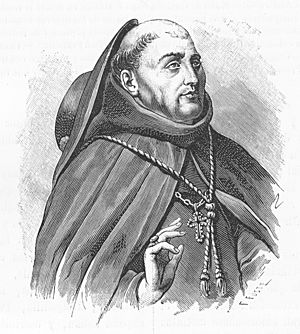Juan de Zumárraga facts for kids
Quick facts for kids His Excellency Don Juan de Zumárraga |
|
|---|---|
| Bishop of Mexico | |
 |
|
| Province | Mexico City |
| See | Mexico |
| Enthroned | August 20, 1530 |
| Reign ended | June 3, 1548 |
| Predecessor | None |
| Successor | Alonso de Montúfar, O. P. |
| Orders | |
| Consecration | April 27, 1533 by Diego Ribera de Toledo |
| Personal details | |
| Born | 1468[?] Durango, Biscay, Spain |
| Died | June 3, 1548 (aged 79–80) Mexico City, New Spain (present-day Mexico) |
| Nationality | |
| Denomination | Roman Catholic |
| Coat of arms |  |
Juan de Zumárraga (1468 – June 3, 1548) was an important Spanish Franciscan leader. He became the very first Bishop of Mexico. He was also the first inquisitor in that region. Zumárraga wrote Doctrina breve, which was the first book published in the Americas by a European. It was printed in Mexico City in 1539.
Contents
Biography
Early Life and Arrival in New Spain
Juan de Zumárraga was born in 1468 or 1469. He came from a noble family in Durango, a province in Spain. He joined the Franciscan Order, a group of Catholic priests. In 1527, he was in charge of a Franciscan convent. He also served as a judge in a court that looked into cases of witchcraft. He believed that many accused witches were simply having visions.
Around this time, more news arrived about the important conquest led by Hernán Cortés in the Americas. On December 20, 1527, King Charles V of Spain suggested Zumárraga for the role of the first bishop of Mexico. Zumárraga left Spain in August 1528. He traveled with other Spanish officials and arrived in Mexico on December 6. He was not yet officially consecrated as a bishop. He was given the title of "Protector of the Indians."
Defending Indigenous People
Zumárraga was officially appointed bishop on August 20, 1530. However, he was not consecrated until April 27, 1533. As the "Protector of the Indians," Zumárraga worked hard to defend the native people. His job was difficult because the Spanish king had not clearly defined his powers. He also lacked full authority since he was not yet a consecrated bishop.
Indigenous people often came to him with many complaints. His fellow Franciscans, who had long worked with the native communities, urged him to stop the abuses by Spanish officials. Zumárraga faced open conflict with these officials. They did not respect his spiritual authority. Some members of other religious groups even supported the mistreatment of the Indigenous people.
Bishop Zumárraga tried to send letters to the Spanish court to report what was happening. However, the officials censored all mail from New Spain. Finally, a sailor from Spain managed to hide a letter in a wax cake inside a barrel of oil. This secret message reached the king.
Meanwhile, news arrived that Cortés was returning to New Spain. Fearing punishment, one of the main officials, Nuño de Guzmán, left Mexico City in December 1529. The remaining officials continued their harsh rule. Zumárraga responded by placing the city under an "interdict." This meant that many church services were temporarily stopped. The Franciscans moved away to Texcoco. Later, the interdict was lifted, but the officials were temporarily banned from the church.
In July 1530, Cortés returned to New Spain. The king appointed new officials, including Sebastián Ramírez de Fuenleal and Vasco de Quiroga. In December of that year, these new officials arrived in Mexico. This brought a time of peace for both Zumárraga and the Indigenous people. The abusive officials were sent back to Spain as prisoners.
However, false stories spread by Zumárraga's enemies made the Spanish court lose trust in him. He was ordered to return to Spain in May 1532. There, he cleared his name. He was finally consecrated as bishop in Spain on April 27, 1533. After another year in Spain, working to gain more rights for the Indigenous people, he returned to Mexico in October 1534. He brought with him skilled workers and teachers for Indigenous girls. He no longer held the title of Protector of the Indians, as it was hoped the new officials would prevent abuses. In November 1535, the first viceroy, Antonio de Mendoza, arrived. This marked the end of the rule by the previous officials.
Efforts to Spread Christianity
Many Indigenous people in Mexico wanted to be baptized. By 1536, it was said that five million Indigenous people had been baptized. This large number meant missionaries had to find a faster way to perform the ceremony. They would gather people, say prayers over everyone, and then pour water on each person's head. They did not use the usual holy oils. This method was accepted while Franciscans were in charge. But when other religious groups arrived, they questioned if these baptisms were valid.
Bishop Zumárraga asked Rome for guidance. On June 1, 1537, Pope Paul III issued a special order. It said that the friars had not done wrong, but in the future, the full baptism ceremony should be used unless it was an emergency.
Another challenge was about marriage. Before the Spanish arrived, some Indigenous cultures allowed men to have multiple wives. When people converted to Christianity, it was unclear which marriages were valid. Zumárraga helped discuss these issues. Pope Paul III decided that converted Indigenous people should keep their first wife as their legitimate spouse.
Zumárraga also received powers as an Inquisitor for the diocese of Mexico in 1535. This meant he could investigate religious crimes. He did not set up a formal court. However, he did investigate a local leader accused of returning to his old beliefs.
Later, a priest named Bartolomé de Las Casas went to Spain. He helped create new laws called the "Nuevas Leyes" (New Laws). These laws strictly banned the enslavement of Indigenous people. They also took away land grants from many Spanish officials and settlers. These laws aimed to protect the native population.
When these new laws arrived in Mexico in 1544, they caused great difficulty. Many Spanish settlers, who had lived through the conquest, would lose everything. They asked Bishop Zumárraga to speak for them. He asked the officials to delay the laws until the king could hear their concerns. Thanks to Zumárraga's careful actions, Mexico avoided a violent conflict.
Final Years and Legacy
In his last years, Bishop Zumárraga worked on many projects for his diocese. He helped establish a school for Indigenous girls. He also founded the famous Colegio de Santa Cruz in Tlatelolco, which was an important school for Indigenous boys.
He was also responsible for bringing the very first printing press to the Americas. This allowed many books to be printed. He helped set up hospitals in Mexico and Vera Cruz. He also encouraged new industries, farming, and manufacturing. He brought skilled workers from Spain to help with these efforts.
In 1546, Pope Paul III made the See of Mexico an Archdiocese. This meant it became a more important religious center. Bishop Zumárraga was appointed the first archbishop. However, he passed away on June 3, 1548, just one month before the official document arrived.
Bishop Zumárraga is also known for helping make chocolate a popular drink among Europeans. Nuns in Oaxaca prepared a cocoa drink with sugar for him. Before this, cocoa had not been widely used in European diets.
See also
In Spanish: Juan de Zumárraga para niños


